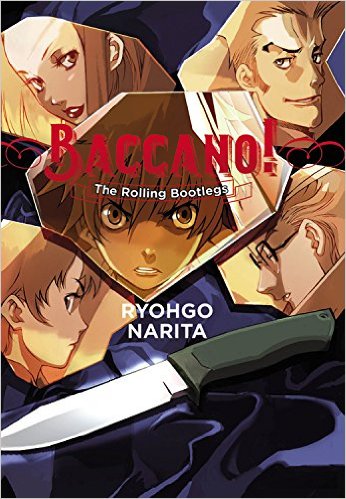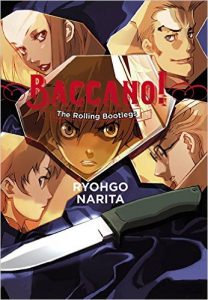By Ryohgo Narita and Katsumi Enami. Released in Japan by ASCII Mediaworks. Released in North America by Yen On.
If you’re familiar with Durarara!!, then you may know that this was the author’s first major series. It also had a (far less successful) anime. That said, the two fandoms don’t really interact, particularly in North America. DRRR’s fandom is very much about two or three characters that people obsess over, while Baccano’s tends to be more about the books themselves, and overanalyzing its cast to death. Given that DRRR is doing well over here, it was a natural pickup, and I am very pleased to see that Yen On is releasing it. This first volume introduces us to much of the main cast, and shows us how they became involved with demons, alchemy, and immortality.
Those familiar with the anime may be disappointed, as we don’t jump around between various time periods in this book (you’ll have to wait till Book 2 for the train). It’s all about what happens in 1930, where various plots are all happening at the same time. A young punk named Firo is joining the ranks of the Camorra (think Mafia, only less Sicilian and more Italian); two incredibly eccentric thieves are trying to turn over a new leaf by stealing for the right reasons, only their reasoning is highly suspect; and an old man and his female chauffeur and bodyguard are trying to resurrect a liquor that will grant complete immortality to anyone who drinks it – something the old man already has, but he wants to recreate it anyway just to show that he can. Gradually these plots and others interact with each other until it all ends in one giant confrontation and there are many dead bodies… of course, given we’re also dealing with immortality, are they really dead?
I suspect the average Baccano! reader over here will already be spoiled as to its plot, which is a shame, as there’s a lot of twists and turns to let us wonder who’s really immortal, who really knows who’s backstory, and what exactly is going on. Like DRRR, the ‘heroes’ of the book are morally ambiguous, in this case mostly being mobsters. Firo is a sweet young kid, except he’s also got a way with a knife, is unflinching at running an illegal gambling den, etc. It’s a matter of degrees. The worst is clearly Szilard Quates, the aforementioned old man, who will use anyone and anything to get what he wants. That said, if you’re looking for a protagonist of this particular volume, I’d say that it’s Ennis, the chauffeur/bodyguard. Thanks to interaction with the cast, she grows and changes more than anyone else, and her inner monologue is both heartbreaking and heartwarming at the same time.
And then there’s Isaac and Miria. They may never be the protagonists of the individual books, but they are the poster children and mascots for the series itself, and their glorious idiocy is on full display here. They both possess an illogical logic, reminiscent of Gracie Allen, and I suspect an entire book of them would be exhausting. But as a spice, they’re perfect. The book gives depth to several characters via thoughts and actions not seen in the anime, and even Isaac and Miria are no exception. It’s never clear if they’re actually lovers or not, but they are most certainly in love with each other. They are a joy and a treat.
It’s hard for me to look at Baccano! with a fresh mind, as I’m so familiar with the series as a whole. For fans of the anime, you’ll see new and changed things. For those who like DRRR, it has a similar chaotic style. If you like characters who are completely trash scum, Dallas Genoard is right up your alley. I would argue that if you are unsure and want to sample the absolute top of the line books in the series, you might wait to sample books 2 and 3 (which come as a set). And the art gets better, honest – it’s very sketchy here, with some characters bearing only minimal resemblance to what they look like 6 or 7 books later. But honestly, this is also an excellent introduction to the clamor and noise that is Baccano!.


On my list to buy, once my budget crunch ends…
I’m part of the fandom that adores Baccano and finds Durarara a confusing, overwrought mess, but have admittedly only seen the anime of each, never having picked up the books.
Hence, my question for you:
My take on Baccano the anime – perhaps not shared by everyone – is that at heart, it’s a story about the joys and power of storytelling itself (hence the framing at the beginning and end of the anime). In your opinion, do the books share that theme?
(One of the reasons I dislike Durarara is I thought it began as an ode to the wonders and mystery of living in the big city – and then just totally lost that thread as the story weaved into a convoluted tangle of nonsense.)
I suspect that all of Narita’s stories are, at heart, agbout taking a bunch of disparate situations and a) tying them all together and b) creating chaos. Baccano is also about what life is, and how to take enjoyiment in it, whether you are mortal or immortal.
And, given (like DRRR) it’s about a bunch of heroes whose morality is questionable (gangsters, thieves, etc.), it’s about doing what you FEEL is the right thing, and the quest to find out what that is. In the first book, that journey is seen via Ennis; in the 2nd, Jacuzzi; in the third (arguably) Chane; and in the 4th Eve, though that’s something of an inversion.
In terms of the storytelling you talk about, well, Carol and Gustav St. Germain aren’t in this book. They do show up later on, but I suspect they were created by Narita for the anime specifically, and then written into later books when he found he liked them. That “who is the main character?” speech was 100% anime, though I’ve no doubt Narita wrote it. This book begins and ends with a Japanese tourist in 2002 being told the story by a Martillo representative after he got mugged in their territory.
Basically, the storytelling parts you like were written by Narita especially for the anime to tie it together, probably as the directors thought it would be cool to use the ‘jump around between timelines’ approach. And, given Narita’s books all lack a true main character (Isaac and Miria are more icons, as is Celty for DRRR), it doesn’t surprise me he’d use that approach to discuss his own work. I don’t believe the Baccano! books are about storytelling, though I do believe they are worth reading.
Thanks for the thoughtful reply. Despite the compelling case you make, I don’t know that I want to revise my thinking on the anime’s overarching theme, but you’ve definitely convinced me to give the books a whirl!
Looking forward to picking this one up! I’m a huge fan of the anime, so I’d love to see what the original work has in store. I like Durarara!! as well, but Baccano’s sheer energy really captured me.